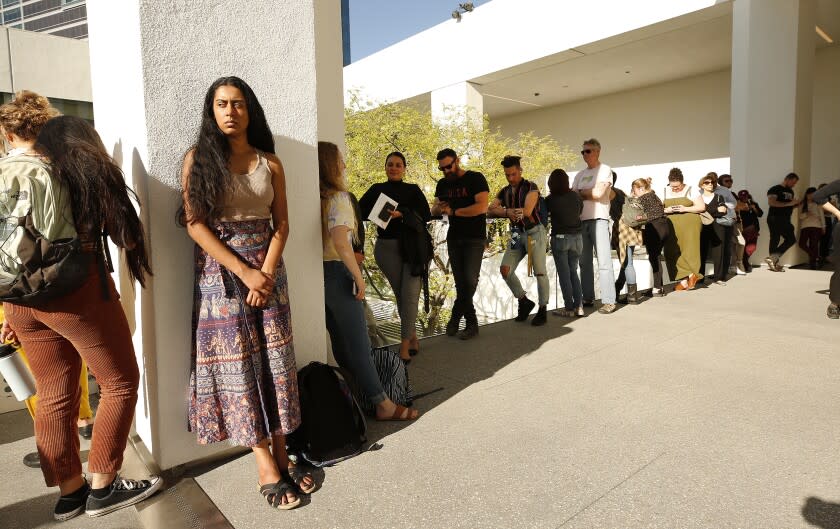Op-Ed: Are Biden and the Democrats in danger of losing young voters?

One of the most remarkable developments in the last two national elections was the surge in voting among young people, historically a low-turnout crowd who proved pivotal to Democrats winning a House majority in 2018 and Joe Biden winning the presidency.
A lingering question has been whether that was a Trump-era anomaly or whether it marked an enduring change in voting behavior.
The good news, according to a new poll of 18-to-29-year-olds released this week by the Harvard Kennedy School’s Institute of Politics, is that turnout among the young is on track to be as high as it was in the 2018 midterms. However, that may bode ill for Democrats — more young Republicans are eager to vote this year than in 2018, and among Democrats, the mojo is fading.
The share of young Republicans saying they will definitely vote in 2022 is up 7 percentage points over this time four years ago; definite Democratic voters are down 5 points. The erosion was especially steep among young Black voters, who now seem less likely to vote than young Republicans.
Among likely voters under 30, 55% still prefer Democratic control of Congress compared with 34% preferring Republican control. But that is about half the 41-point partisan advantage Democrats enjoyed in the spring 2018 poll, when 69% favored Democratic control and 28% preferred Republican control.
This poll is only the latest of several recent surveys showing that President Biden’s approval rating is sinking among young voters. That could take a toll on Democrats in the midterm elections, and is putting pressure on Biden to act on youth-oriented issues such as student loan debt forgiveness and climate change before election day.
The White House is getting the message. Harvard officials and students who worked on the poll met with the president and senior White House advisors on Monday to discuss their findings. They also met with Republican Party officials in Washington. Clearly, the Democrats can’t take their dominance among young voters for granted.
It has been easy for Democrats to assume that high youth turnout is an unalloyed boon because millennial and Gen Z voters tend to be more progressive. The challenge has been to mobilize them to vote, not convince them which party to back. But now it looks like the party also has some persuading to do, amid disappointment over Biden’s performance.
“Democrats in 2022 have to do both, mobilize and persuade,” said John Della Volpe, the Institute of Politics polling director, who took a leave from Harvard in 2022 to advise Biden’s presidential campaign. “Only 69% of young Americans who voted for Biden in 2020 approve of his job performance today.” The leading reasons young voters cited for their disapproval of Biden is “ineffectiveness” and “not following through on campaign promises.”
One of Biden’s best shots at turning this around would be to deliver on student debt forgiveness, a crisis that hits young people hard. He’s expected to announce new debt relief before the current pause on loan payments expires Sept. 1, but it’s not clear how far he will go.
The poll found broad consensus in favor of some kind of government action on the issue, but less agreement on exactly what form it should take. A plurality of 38% (including 43% of Democrats and 13% of Republicans) favor canceling student loan debt for everyone; 21% favor cancellation for those in most need; 27% favor other government-assisted repayment options, not cancellation. Just 13% believe policy should not change at all.
Ben Wessel, former executive director of NextGen America, the nation’s largest political group focused on organizing young people, said Democrats will have to do a better job of building bridges to skeptical youth, not just show up in get-out-the-vote drives.
“Democrats need to ask, how do we get GOP-leaning young people to vote for Democrats and how do we get young Black folks motivated to vote?” he says. He believes Democrats should highlight the sharp differences between the two parties on social policies such as abortion, LGBTQ rights and gun regulations.
The Harvard poll also found that a growing number of young people see both parties as more focused on the interests of the elite than on “people like you.” They feel this way most strongly about Republicans, but Democrats are also vulnerable to this critique.
That’s why, looking past the midterms, the biggest risk to Democrats may be that too many disaffected young voters will turn to third-party candidates, as they did in 2016 to the detriment of Hillary Clinton. Democrats were lucky in 2020 that no effective third-party candidates ran and tempted young people to abandon Biden. They may not be so lucky in 2024.
Janet Hook is a former national political reporter for the Los Angeles Times.
This story originally appeared in Los Angeles Times.

